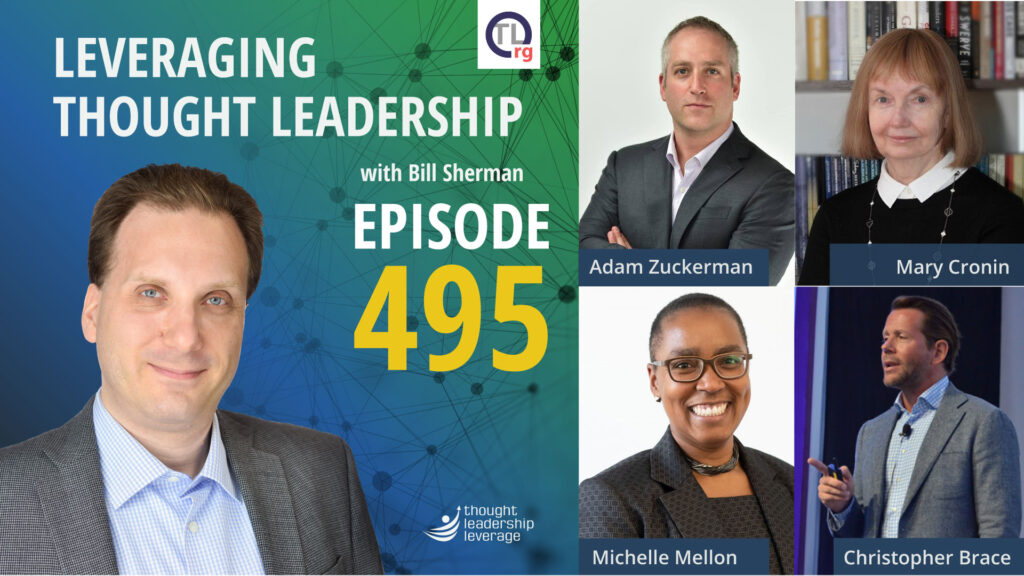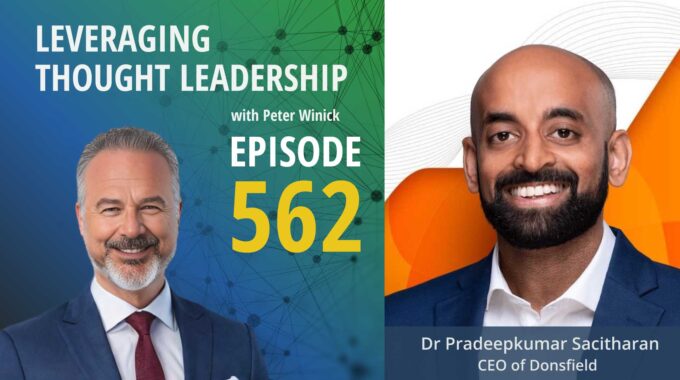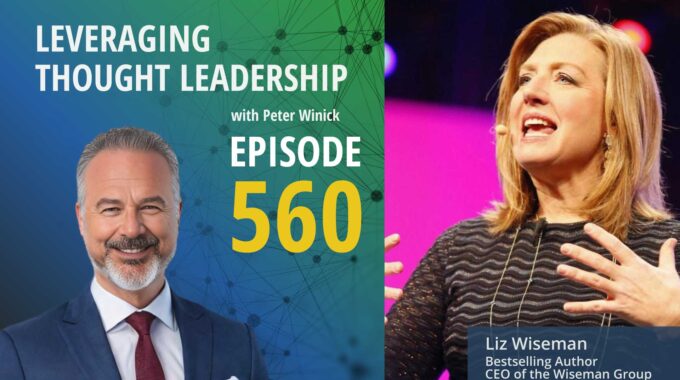Strategies for Shaping the Future of Healthcare A conversation with Dr. Helen Messier about what…
Storytelling with Thought Leadership | Adam Zuckerman, Mary J. Cronin, Michelle Mellon, and Christopher Brace

Connecting storytelling to thought leadership.
A compilation of advice for using storytelling for impactful thought leadership.
Storytelling is one of the most powerful ways you can elevate your thought leadership.
It can create an emotional connection, convey the need for change, or provide a vision of the future.
In this episode, we collect advice from our experts on the various ways a thought leader can utilize the storytelling skill to elevate their content.
Adam Zuckerman is Product Leader, Employee Engagement Software at Willis Towers Watson. Adam shares how his personal approach of sharing experiences in storytelling can help connect the research and data you provide with your audience in meaningful ways.
Mary Cronin is a Research Professor at the Carroll School of Management, Boston College. She teaches about entrepreneurship, and explains to us how storytelling is a vital component of the success of both thought leaders and startups.
At the time of publication, Michelle Mellon was the Thought Leadership Director of SalientMG. She is also a published fiction author. Michelle takes her experience writing stories and applies those same principles to writing thought leadership explaining how the fundamentals of storytelling need to be followed, as well as how they can be broken to create engaging narratives.
Our final guest is Christopher Brace, Adjunct Professor of Marketing at MICA. Christopher helps us understand how storytelling can be used in marketing to build brands. He explains how, by employing a listening ear, you can discover the emotional territories of your audience that will help you know what resonates most with them.
Three Key Takeaways:
- Storytelling is a component of the success of entrepreneurs and thought leaders; yet storytelling is often neglected.
- Don’t be afraid to provide predictions for the future in your thought leadership. Your speculation doesn’t have to be 100% right it just has to provide a glimpse of what could be around the corner.
- When starting a narrative look at the questions of “What if” but ensure the basic elements of storytelling are not forgotten.
If you need a strategy to bring your thought leadership to market, Thought Leadership Leverage can assist you! Contact us for more information. In addition, we can help you implement marketing, research, and sales. Let us help you so you can devote yourself to what you do best.

Transcript
Bill Sherman Adam Zuckerman. He’s at Willis Towers Watson.
Bill Sherman One of the things that I’m excited to talk to you about is how you have intentionally shaped the voice of your thought leadership. I know you have training as an academic and that you look at a topic employee engagement, which can be very quantitative, but you often use a personal approach to storytelling. And if I can put you on the spot a little bit, I want to relate to something that you posted this morning as we’re recording about your experiences when you were 11 at sleepaway camp. If you could maybe summarize that story and then let’s sort of dig into it from a thought leadership perspective.
Adam Zuckerman Sure. Yeah. Thanks for that. Well, that post was about a summer when I was 11 years old. And I volunteer for something called Survival, which of course subsequently became a television show, having nothing to do with that. But this was years before. This is 1980, I think. And they had a program, a sleepaway camp called Survival, where you would leave, leave the camp, and they would take you off into the woods and leave you there for 24 hours. They give you some basic training about how to build a shelter and so forth, and you got very limited supplies and they were basically drop you off. And if you made it 24 hours, they come back 24 hours. And if you if you had made it, then you got this gold necklace and you had survived. And so I volunteered to do this in retrospect, unwisely. But it seemed kind of cool. And it was a total disaster. I didn’t pay attention to any of the training they gave, and I wound up it wound up raining. I mean, torrential, biblically raining it all night long. And I hadn’t prepared at all. And it was it was a really incredible, indelible, kind of enduring experience for me. And I remember with great clarity, they gave you a whistle, a plastic whistle that you blow in case of emergency. You know, the camp the camp leaders weren’t that far away. Obviously, it seemed like it when you’re a kid. But and if there’s a problem, they come and get you. And when the rain came, I blew. That was like you wouldn’t believe. And I and a guy came out and said, What’s the problem? I said, I want to go home, go back to camp, you know, right now. And he wouldn’t take me. He said, you can do this. And the Post was about that experience and how and I did do it and I did make it. And in retrospect, how much I valued it and I valued him and what he did right, which was he? He kind of believed in me more than I believed in myself. I was panicking. I was essentially in tears. And he was saying, now it’s all right, you can get through this. And he was right. And so that’s what the Post was about. It was about leaders who believe in employees sometimes more than they believe in themselves and how powerful that can be.
Bill Sherman So what I loved about that at the end is I realized as I got older, I wanted to be that leader. Right. And so you were speaking to the experience of your younger self and then connecting it to who you wanted to be today. Talk to me in terms of the conscious choices you’re making in creating the voice for your thought leadership. Because as I said, it could be sort of very academic or very metrics oriented. You’ve led with story and you’ve led with narrative. That seems a choice.
Adam Zuckerman Yeah, I mean, it is. And I think I mean, part of it is I’m you know, I’m a frustrated writer and to some extent. And I know that and I know that story resonates with people. But I mean, that’s also just how I experience it. It’s how I experience working in the world. And so, yeah, I have academic training and I have extensive training in statistics and methodology, and that’s all valuable. But ultimately, I do think, you know, it’s the experience we all have and the emotions that we all have around work that really are important and make the difference. And, you know, I mean. I wouldn’t exactly say this, but it’s a little corny, I suppose. But I mean, all the academic literature and all the research is adds tremendous value. But to me, a lot of the a lot of the best decisions and the right kind of judgment is intuitive. You know, it’s sort of, you know, you know what to do in the moment. And so I guess that’s partly what I’m relying on as well. Right? It’s just the research and all that and all the statistics are great and inform, you know, creation, best practices and all the rest. But ultimately, I think it comes down to your own experience and your perspective. And a lot of that is sort of, you know, more fundamental than and even the research and the quantitative data.
Bill Sherman So a friend of mine, he uses the example that often research provides data and validation for things which are intuitive but you’re not certain of. And I think making that invisible instinct visible, whether through story or data, is really some of the heavy lifting work of followership.
Adam Zuckerman Yeah, I agree. I think the data makes it. The data confirms it, as you say, the data validated, but the data also makes it, you know, sort of requires that it provokes action. I mean, we do employ surveys for companies all over the world. And I’ve done this work for a very long time and very, very, very rarely do I come in and run an employee survey and share the results with executives and share something they didn’t already know. Mm hmm. I mean, and the thing, you know, they pay a lot for the service and they put a lot of effort into it. And it’s valuable. But at the end of the day, most of what we come up with, they already know. It validates it, it quantifies it. It puts it in front of in a way that provokes action. And that’s where a lot of the value is, right? It’s not necessarily saying, here’s something you really had no idea was going on in your organization and we’ve uncovered it. The fact is, you know, with all of these things already, we’re putting we’re putting some language around it and some terms around it that allows you to understand it maybe a bit better and focus it and focus as action. And that’s really what all that data does, I think.
Bill Sherman Dr. Mary Cronin, she’s a research professor at Boston College. Many entrepreneurs are visionary, but you don’t have to be a visionary to be an entrepreneur, right? But that sense of building the future, of making something new or serving a need that hasn’t been served before requires storytelling, especially if you’re doing something like creating a new market and you’re doing category creation where you have to convince people this is not only a problem, but it’s a solvable problem.
Mary Cronin Yes. And right away, you are posing some questions that I think we want to debate a bit, because I agree with you that it is not necessary to be a visionary, to be an entrepreneur. And I also agree that it is essential for any successful company at any stage to be able to articulate their story in a compelling way. So storytelling is a component of entrepreneurship success, and I believe also of thought leadership success. What I think is different in my perspective is that the bias towards change, towards action, towards actually being the person that makes the change happen is so much stronger in the entrepreneurial mindset and in the thought leader mindset. It’s articulating the change so that whether or not that change that a company wants to bring into being is completely solving a problem that no one else has tackled yet and making the world a better place as a result, or simply changing customer behavior. So they buy a product from this startup or this company and not another company. Those kinds of changes that take place in the market and in society and everything in between, they have to be high on the list for entrepreneurs to master. To start a company that survives and thrives in this highly competitive business world. And to get back to your storytelling point. Storytelling maybe is at the heart of thought leadership, but is only one component and often a neglected component of entrepreneurship. And that has raised in my mind as I thought about our conversation, a paradox. Why isn’t every entrepreneur? In essence, a nascent or an accomplished thought leader. If entrepreneurs are out to change the world, if they’re out to solve a problem, if they want to accomplish something through action, it is in their interests, I believe, to be able to articulate why they are doing it in a way that can be understood by the broader market, by their customers, by their employees, or the talent that they want to attract by their potential investors and partners. And yet I see a lot of entrepreneurs who don’t even put that leadership on their priority list. When you start.
Bill Sherman That’s an interesting thing because one of the things from my side that I’ve seen is I’ve seen start ups that have been going on a fundraising tour, basically using thought leadership as one of the designated uses of capital for the thought leap or for the fundraising, right. So that they are going to position themselves in the market to create demand or distinguish and tell their story. And so I think from a very savvy perspective, it’s a way to grow and get attention rather than say, okay, we’re going to talk to industry analysts, we’re going to talk to do some traditional PR, etc. that only goes so far. Right. How are you going to change the conversation from the way that the world is working? And if you can show investors that you’ve got a plan for that, that’s useful.
Mary Cronin I agree with you. And I would also remind you that we started this conversation saying that entrepreneurs don’t have to be visionaries and that not all entrepreneurs are, in fact, visionaries. The parallel to that is most entrepreneurs are not out on fundraising tours, right? Booking analyst conversations. They are busy trying to bootstrap their companies and to achieve their vision that way. And those are the entrepreneurs I think I am mostly thinking about. Of course, I’m interested in those who can make a big launch with a nice fund raise. But in terms of the number of entrepreneurs who are entering the marketplace every year, the vast majority are not raising that kind of investment. And yet I feel strongly they would still benefit from and be very well served by thinking about how to create a thought leadership position for themselves and their companies.
Bill Sherman If you’re enjoying this episode of leveraging thought leadership, please make sure to subscribe. If you’d like to help spread the word about our podcast, please leave a five star review at ratethispodcast.com/ltl and share it with your friends. We’re available on Apple Podcasts and on all major listing apps as well as thoughtleadershipleverage.com forward slash podcasts.
Bill Sherman Michelle Miller. She’s the thought leadership director at Salient AMG. She’s also written and published short stories. When you’re talking about speculative fiction or horror. It begins with a what if? QUESTION Right. And so I think that’s a great place to play with the intersection of thought, leadership and storytelling is where do you begin with the whatever?
Michelle Miller I think in terms of the thought leadership that I’m working on for clients, I’m helping them develop their platform is that’d be their idea for what they’re going to talk about. It’s always going to be this what if scenario. So we know what’s happening in the world right now, but with thought leadership, we want to dive a little bit deeper. We want to say what are the trends? What is coming around the corner? What is this thing that’s happening now turns into this thing that’s happening tomorrow? And so I think there’s always a very strong speculative element in thought leadership as well. And that’s something that I want to encourage, you know, my clients and other thought leadership practitioners to embrace, but then also want to make sure that the basic elements of storytelling are also included in that so that, you know, there’s a beginning, middle and an end to whatever clients are trying to convey with their fabulous.
Bill Sherman Well, and I want to get to the narrative journey in a moment, but I want to pull out a little bit of a thread that you mentioned. So you talked about what if and what could be. But often much of what we read is what is that’s the news today or what was right. We read things from the past. And so it is a little bit of a different focus to be able to ask the question and say, let’s write the story of the future and figure out how to get there.
Michelle Miller I think that’s a difficulty for most people. I mean, I like I said, I love speculative fiction, but sometimes it’s difficult for me as a fiction writer to sit down and say, okay, what is the world going to look like in 5000 years? What is the world look like on another planet somewhere? And then you go into that as a writer and you figure that out. You create that world. I think there’s probably a hesitancy in terms of thought leadership to do that because you’re going to be judged on what you’re placing in front of people, and it’s not going to be a different world and another galaxy 100 years from now, it’s going to be something that business leaders and innovators and the founders are looking at as a guidepost for where they can be in ten years. And there’s I think there’s a lot more pressure to do that.
Bill Sherman And with that time frame, some thought leadership may be ten years out. It could be five. You could even be talking about a transformation, an issue 12 to 18 months, depending on what industry or sector you’re in. And so your proof point comes a whole lot sooner. Right.
Michelle Miller Absolutely. Yes. Yeah. But I think if you’re if you’re telling the right story and you’re engaging people in that vision that you have, then they’re a little more likely to buy in and say, okay, maybe I don’t get every single point and I don’t agree with every projection that you’ve made, but you’re telling it in a way that makes me think. And I think, you know, obviously thought is part of thought leadership. You want people to think you want people to think in new way. You want them to think about things that they haven’t thought of before. And you want them to think maybe this is something that I can apply and what I’m doing or what my organization is doing. And we can make a change. We can turn things along.
Bill Sherman Absolutely. And as a genre is speculative fiction, for example, doesn’t have to be 100% correct. It’s about leadership. You don’t have to be 100% correct either. You have to just be able to peer around the corner into the future to see something that’s valuable and say, okay, if this is true, here’s what you should do today.
Michelle Miller Right. And I think that I mean, I think that that point is really key for storytelling in general. It doesn’t have to be press. You have to communicate an idea and you have to communicate it in a way that it resonates with someone and that they can engage with it and embrace it. But it doesn’t have to be perfectly correct. It doesn’t have to follow all the rules. It doesn’t have to follow the predictable path. It just has to take at least one person to bring them in and get them on board with what you’re thinking.
Bill Sherman So earlier, you laid out a predictable path. All stories have a beginning, middle and an end. And the beginnings. What comes first? And then comes the middle. And then comes the end. But you just said that sometimes breaking those rules is what makes a story interesting. How do you tell engaging stories in thought leadership and how do you either follow the rules or break them?
Michelle Miller That’s a great question, I think. I mean, to go back to what I said, though, the beginning, the middle and an end. Those are the elements of storytelling. But I think we’re seeing more and more that when you mix those up, maybe you start in the middle and then you have the end in the beginning, or you start at the end and you look really backwards. That’s playing with the format of the narrative can also be interesting and engaging. And, you know, like we just said, there’s no right or wrong and slight elements. And so I think you also have to let yourself go when you’re when you’re doing storytelling and thought leadership and think, I don’t necessarily have to tell this in a way that everyone else has. I’m writing an article or I’m doing a podcast or, you know, whatever format it comes in. I don’t have to do it in the way that everyone else does. But I think that, you know, you have to remember that there’s all these elements you want to include. You want to have some sort of central character, a protagonist, or, if you will, town. And then you want to talk about the effect of that protagonist fiction, challenge, whatever it is, and you want to offer some sort of resolution or you want to leave people with the idea that there are multiple options for resolution so that if you challenge or whatever that protagonist becomes. So I think it’s more about a focus on the elements of storytelling and then figuring out how they come together to best tell your story. I don’t think there’s a prescriptive way to do that. I mean, I think if you read my story, you can tell by my voice that they’re all by me. But I use different formats that I might use first person, I might use third person, and that I might start at the beginning for this one. And it’s a very traditional narrative. I just wrote a short story that’s entirely true. And so I think the story is going to tell you how it needs to be told.
Bill Sherman And Christopher Bracey has spent his career in the marketing and agency world working on projects for global food and packaged good brands. From a marketing perspective of building that relevance, that resonance, that connection which we’ve talked about, is that first step. How do you do that? And what could have thought leadership practitioner learn from the world of CPG?
Christopher Brace So I think this is probably be one of the biggest struggles brands have, which is how do I understand what that deeper, emotionally resonant story is that my brand can tell? So we’re going to go in a little bit of a different direction here, because I’m going to I’m going to talk a little bit about the word story. I’m actually right now working on a new project and I’m doing a ton of reading and academic studies about the importance of stories intergenerationally across families and how vitally important they are and creating a very strong sense of not only self-identity but identity for the family. And so if a brand wants to understand what is that deeper, emotionally resonant story, what you need to do is you need to talk to your consumers and get them to tell you the stories that they have that are related to the different emotional territories that that brand owns or sits in. And most research is and brand people know what those emotional territories are. But what we often do is when we research, we research the surface of that rather than researching the depths of it. And it is the depth of it. That’s where that emotionally resonant story sits. And I think the reason that we do this is because we focus too much on the product rather than the bigger emotional idea that sits above it. And I think it’s too few brands know what this is.
Bill Sherman So let’s unpack that a little bit. And let’s stay using sort of the CPG world, the focus group as an example. I can imagine plenty of focus group conversations where you sit up on top and you’re talking about different brand promises or packaging or positioning and that sort of thing. How do you focus group or not go after getting someone to tell you the stories that align to that territory? How do you draw them out? What sort of questions do you ask and in what environment? Because it almost sounds anthropological in nature. It is.
Christopher Brace It is, absolutely. And that’s a great way of saying it. Well, the process that we used and it was a research methodology that I kind of created and evolved over time was what we call facilitated storytelling. And basically, we don’t do it in a focus group because I read this study years ago is two really smart women did a study and they said that it takes an average of 22 minutes of the typical, what I would call facilitated dialog in a typical qualitative setting where the moderator asks a question, there’s some discussion and they ask probing questions, and then you get on to the next question. In that setting, it takes an average of 22 minutes for any one person to actually get beyond their conscious, rationalized explanation and then get down into the deeper emotional territory. So what we need to do is we need any type of research methodology that skips the first 22 minutes and gets right to minute 23. And the best way to do that, I found, is by engaging people in telling stories about their lives. You know, sociology and anthropology has taught us that people reveal their non-conscious emotional truths through the stories they tell about their lives. So really, it’s a matter of how do you ask the right questions to get the right stories, and then how do you listen with that storytelling ear to understand what is that story telling me about them?
Bill Sherman So can you give me an example that opens that up a little bit more and fleshes it out?
Christopher Brace Yeah, I mean, we did a I’m going to use I’m going to use sort of Simmons bedding because I know you interviewed Melanie Hewitt and I worked with her on their brands. And the questions, the fundamental question was, how do we sell something more than a mattress? And if there is something more than a mattress, what is that?
Bill Sherman So the matter is you think of as in many ways as a commodity, right?
Christopher Brace Yes, exactly. I mean, and when you look at the competitive analysis, it is they all say exactly the same thing and they use the same terminology. And it’s all very confusing and it’s very hard for consumers to sort through it. But there’s I mean, you think about this. What do we spend a third of our life, a third of every day doing? Sleeping. So it’s pretty important. So there is an immense amount of stuff to talk about there. So what we did is we actually did qualitative research, but where we interviewed people in friendship dyads. So these are two people who have a very close emotional relationship. What that does is it allows them to be much more vulnerable and honest, and you get such deeper research results. And what she you know, what we did is we talked about things like, So I want you to think back in the past, like 2 to 3 months when you woke up feeling great and you were ready to tackle whatever you had to tackle that day. Shouldn’t be a special occasion, not a wedding or anything like that. Just it was an every day from Monday through Friday, you had to go to work. You woke up and feeling really great and then you just. Now, tell me about that experience. What did it mean for you? How did the people around you react to you, your significant other, your kids, your coworkers, your boss, whatever it might be? And it’s amazing what you find. People observe very deep things about themselves as they tell those stories. And then really, once they tell the story, the role that the story plays is it makes it opens them up emotionally, it makes them vulnerable. So then the researcher can start asking those questions that you really want to start asking at many minute 23, not minute one through 22, but minute 23. And that’s when they reveal all the goals.
Bill Sherman If you’re interested in organizational thought leadership, then I invite you to subscribe to the OrgTL newsletter. Each month we talk about the people who create, curate and deploy thought leadership on behalf of their organizations. Go to the website. OrgTL.com and choose. Join our newsletter. I’ll leave a link to the website as well as my LinkedIn profile in the show notes. Thanks for listening and I look forward to hearing what you thought of the show.





